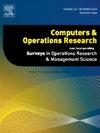Optimal departure-time advice in road networks with stochastic disruptions
IF 4.3
2区 工程技术
Q2 COMPUTER SCIENCE, INTERDISCIPLINARY APPLICATIONS
引用次数: 0
Abstract
Due to recurrent (e.g. daily or weekly) patterns and non-recurrent disruptions (e.g. caused by incidents), travel times in road networks are time-dependent and inherently random. This is challenging for travelers planning a future trip, aiming to ensure on-time arrival at the destination, while also trying to limit the total travel-time budget spent. The focus of this paper lies on determining their optimal departure time: the latest time of departure for which a chosen on-time arrival probability can be guaranteed. To model the uncertainties in the network, a Markovian background process is used, tracking events affecting the driveable vehicle speeds on the links, thus enabling us to incorporate both recurrent and non-recurrent effects. It allows the evaluation of the travel-time distribution, given the state of this process at departure, on each single link. Then, a computationally efficient algorithm is devised that uses these individual link travel-time distributions to obtain the optimal departure time for a given path or origin–destination pair. Since the conditions in the road network, and thus the state of the background process, may change between the time of request and the advised time of departure, we consider an online version of this procedure as well, in which the traveler receives departure time updates while still at the origin. Numerical experiments exemplify a selection of properties of the optimal departure time and, moreover, quantify the performance of the presented algorithms in an existing road network – the Dutch highway network.
随机干扰下路网的最优出发时间建议
由于经常性的(如每天或每周)模式和非经常性的中断(如事故造成的),道路网络中的旅行时间依赖于时间,本质上是随机的。对于计划未来旅行的旅行者来说,这是一个挑战,他们既要确保准时到达目的地,又要限制旅行时间的总预算。本文的重点在于确定他们的最优出发时间,即能保证选定的准时到达概率的最晚出发时间。为了模拟网络中的不确定性,使用了马尔可夫背景过程,跟踪影响链路上可驾驶车辆速度的事件,从而使我们能够合并周期性和非周期性影响。它允许评估旅行时间分布,给定该过程在出发时的状态,在每一个单独的环节。然后,设计了一种计算效率高的算法,利用这些单独的链路旅行时间分布来获得给定路径或出发地对的最优出发时间。由于道路网络的状况以及后台进程的状态可能在请求时间和建议出发时间之间发生变化,因此我们也考虑了该程序的在线版本,在该程序中,旅行者仍在原点时接收出发时间的更新。数值实验举例说明了最佳出发时间的选择特性,此外,量化了现有道路网络-荷兰公路网中所提出的算法的性能。
本文章由计算机程序翻译,如有差异,请以英文原文为准。
求助全文
约1分钟内获得全文
求助全文
来源期刊

Computers & Operations Research
工程技术-工程:工业
CiteScore
8.60
自引率
8.70%
发文量
292
审稿时长
8.5 months
期刊介绍:
Operations research and computers meet in a large number of scientific fields, many of which are of vital current concern to our troubled society. These include, among others, ecology, transportation, safety, reliability, urban planning, economics, inventory control, investment strategy and logistics (including reverse logistics). Computers & Operations Research provides an international forum for the application of computers and operations research techniques to problems in these and related fields.
 求助内容:
求助内容: 应助结果提醒方式:
应助结果提醒方式:


